Genome-Wide Identification, Characterization and Expression Analysis of the Solute Carrier 6 Gene Family in Silkworm (Bombyx mori)
- PMID: 27706106
- PMCID: PMC5085708
- DOI: 10.3390/ijms17101675
Genome-Wide Identification, Characterization and Expression Analysis of the Solute Carrier 6 Gene Family in Silkworm (Bombyx mori)
Abstract
The solute carrier 6 (SLC6) gene family, initially known as the neurotransmitter transporters, plays vital roles in the regulation of neurotransmitter signaling, nutrient absorption and motor behavior. In this study, a total of 16 candidate genes were identified as SLC6 family gene homologs in the silkworm (Bombyx mori) genome. Spatio-temporal expression patterns of silkworm SLC6 gene transcripts indicated that these genes were highly and specifically expressed in midgut, brain and gonads; moreover, these genes were expressed primarily at the feeding stage or adult stage. Levels of expression for most midgut-specific and midgut-enriched gene transcripts were down-regulated after starvation but up-regulated after re-feeding. In addition, we observed that expression levels of these genes except for BmSLC6-15 and BmGT1 were markedly up-regulated by a juvenile hormone analog. Moreover, brain-enriched genes showed differential expression patterns during wandering and mating processes, suggesting that these genes may be involved in modulating wandering and mating behaviors. Our results improve our understanding of the expression patterns and potential physiological functions of the SLC6 gene family, and provide valuable information for the comprehensive functional analysis of the SLC6 gene family.
Keywords: Bombyx mori; expression pattern; motor behavior; nutrient absorption; the solute carrier 6 (SLC6) gene.
Conflict of interest statement
The authors declare no conflict of interest.
Figures
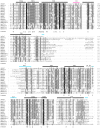

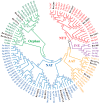
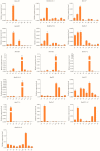

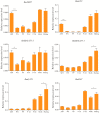
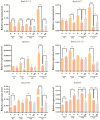

Similar articles
-
Characterization and identification of the integrin family in silkworm, Bombyx mori.Gene. 2014 Oct 1;549(1):149-55. doi: 10.1016/j.gene.2014.07.060. Epub 2014 Jul 24. Gene. 2014. PMID: 25064490
-
Genome-wide identification of chitin-binding proteins and characterization of BmCBP1 in the silkworm, Bombyx mori.Insect Sci. 2019 Jun;26(3):400-412. doi: 10.1111/1744-7917.12552. Epub 2018 Feb 4. Insect Sci. 2019. PMID: 29087606 Free PMC article.
-
Identification and Characterization of 30 K Protein Genes Found in Bombyx mori (Lepidoptera: Bombycidae) Transcriptome.J Insect Sci. 2015 Jun 15;15(1):71. doi: 10.1093/jisesa/iev057. Print 2015. J Insect Sci. 2015. PMID: 26078299 Free PMC article.
-
Genome-wide identification and characterization of Fox genes in the silkworm, Bombyx mori.Funct Integr Genomics. 2015 Sep;15(5):511-22. doi: 10.1007/s10142-015-0440-5. Epub 2015 Apr 17. Funct Integr Genomics. 2015. PMID: 25893708 Review.
-
Molecular Functions and Physiological Roles of Gustatory Receptors of the Silkworm Bombyx mori.Int J Mol Sci. 2024 Sep 21;25(18):10157. doi: 10.3390/ijms251810157. Int J Mol Sci. 2024. PMID: 39337641 Free PMC article. Review.
Cited by
-
Genome-Wide Analysis of the Amino Acid Auxin Permease (AAAP) Gene Family and Identification of an AAAP Gene Associated with the Growth and Reproduction of the Brown Planthopper, Nilaparvata lugens (Stål).Insects. 2021 Aug 18;12(8):746. doi: 10.3390/insects12080746. Insects. 2021. PMID: 34442311 Free PMC article.
References
-
- Meleshkevitch E.A., Assis-Nascimento P., Popova L.B., Miller M.M., Kohn A.B., Phung E.N., Mandal A., Harvey W.R., Boudko D.Y. Molecular characterization of the first aromatic nutrient transporter from the sodium neurotransmitter symporter family. J. Exp. Biol. 2006;209:3183–3198. doi: 10.1242/jeb.02374. - DOI - PubMed
MeSH terms
Substances
LinkOut - more resources
Full Text Sources
Other Literature Sources

